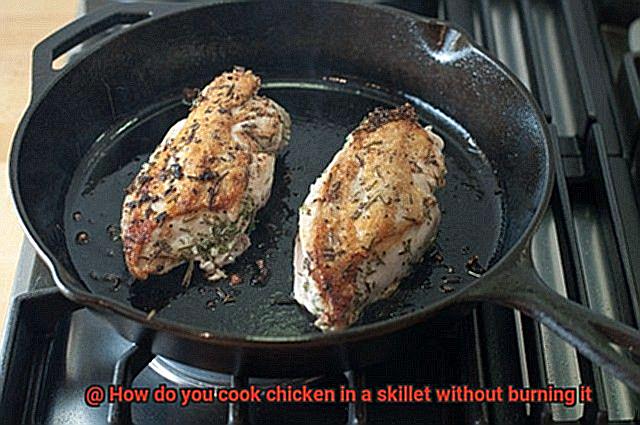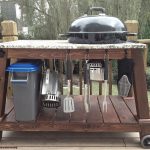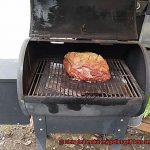The sound of sizzling chicken in a skillet is music to the ears. The aroma wafting from the pan can make mouths water, and the juicy texture is what makes it one of the most beloved meats around. However, cooking chicken in a skillet can be tricky business. Burning the chicken is a common problem that results in an unpleasant meal with dry and tough meat.
No one wants to end up with charred or overcooked chicken. That’s why we’ve put together a comprehensive guide to help you perfect your skillet-cooking technique. In this article, we’ll share practical tips and tricks to ensure your chicken is always moist, tender, and perfectly cooked every time.
We’ll cover essential points such as selecting the right skillet and heat level, preparing the chicken, and monitoring the cooking process closely. We’ll also discuss common mistakes made when cooking chicken in a skillet and how to avoid them.
Whether you’re new to cooking or an experienced pro, our guide will take your skillet-chicken-cooking skills to new heights. So grab your favorite skillet and let’s get started.
Contents
What Kind of Skillet is Best for Cooking Chicken?
Cooking chicken can be a daunting task, especially if you’re not using the right kind of skillet. The type of skillet you use can make all the difference in achieving perfectly seared and juicy chicken. So, what kind of skillet is best for cooking chicken?
Firstly, a non-stick skillet is essential for cooking chicken. Not only does it prevent the chicken from sticking to the pan and burning, but it also makes for easy clean-up. Additionally, consider the material of the skillet. Cast iron skillets are great for cooking chicken as they retain heat well and distribute it evenly. On the other hand, stainless steel skillets are durable and easy to clean, making them a versatile option that can be used on any stovetop.
Size matters when it comes to choosing the right skillet for cooking chicken. A skillet that is too small will cause overcrowding, leading to uneven cooking and burning. On the other hand, a skillet that is too large may not heat up evenly and could also lead to burning. Choose a skillet that is just the right size for the amount of chicken you plan to cook.
The handle of your skillet is an important factor to consider as well. Look for a skillet with a sturdy handle that stays cool while cooking so you can safely move it around on the stove.
Before cooking the chicken, make sure it’s at room temperature and pat it dry with paper towels to remove any excess moisture that could cause sticking and burning. When cooking, avoid overcrowding the pan and use a medium heat setting on your stove. Use oil or butter sparingly to prevent greasiness and burning or try using a cooking spray.
Lastly, investing in a high-quality skillet will pay off in the long run. While cheaper options might seem tempting, a well-made skillet will provide better results and save money by not needing to be replaced as often.
Preparing the Chicken Before Cooking
Firstly, it’s crucial to wash the chicken thoroughly with cold water to remove any bacteria or dirt that may be present on the surface. Pat the chicken dry with paper towels to remove any excess moisture after washing. This prevents the chicken from sticking to the skillet and ensures even cooking.
Next, season the chicken with your desired spices and herbs. Ensure that you evenly coat each piece of chicken with the seasoning for maximum flavor. Don’t be afraid to experiment with different spices – some of my favorites include garlic powder, paprika, and thyme.
Trimming any excess fat or skin from the chicken is also important. It not only makes the chicken healthier but also ensures that it cooks evenly in the skillet. As we all know, burnt on one side and undercooked on the other is not ideal.
One last tip to consider before cooking is bringing the chicken to room temperature. Leave it on a plate for 30 minutes to an hour before cooking. This will help the chicken cook more evenly and prevent it from drying out.
Avoid Overcrowding the Pan
Firstly, let’s delve into why overcrowding the pan is such a big no-no when it comes to cooking chicken. When too many pieces of chicken are crammed into a small pan, they release moisture and steam instead of browning, leading to soggy and unevenly cooked pieces. Not what we want.
To avoid overcrowding the pan, there are several measures you can take. Firstly, consider using a spacious skillet or cooking in batches. This way, each piece of chicken will have enough breathing room to cook evenly and prevent sticking. It may require a little extra effort, but trust me, it’s worth it for that perfect end result.
Additionally, ensure that your chicken is dry before adding it to the skillet. Pat each piece with a paper towel to remove any excess moisture that can cause steaming and prevent browning. A dry piece of chicken will sear quickly and create a crispy crust that locks in all those delicious juices. Yum.
Last but certainly not least, preheating your skillet before adding the chicken is crucial. A hot skillet will sear the meat quickly, creating that coveted crispy crust we all adore. Adding chicken to a cold skillet will take longer to cook and may stick to the pan, leading to burning and frustration.
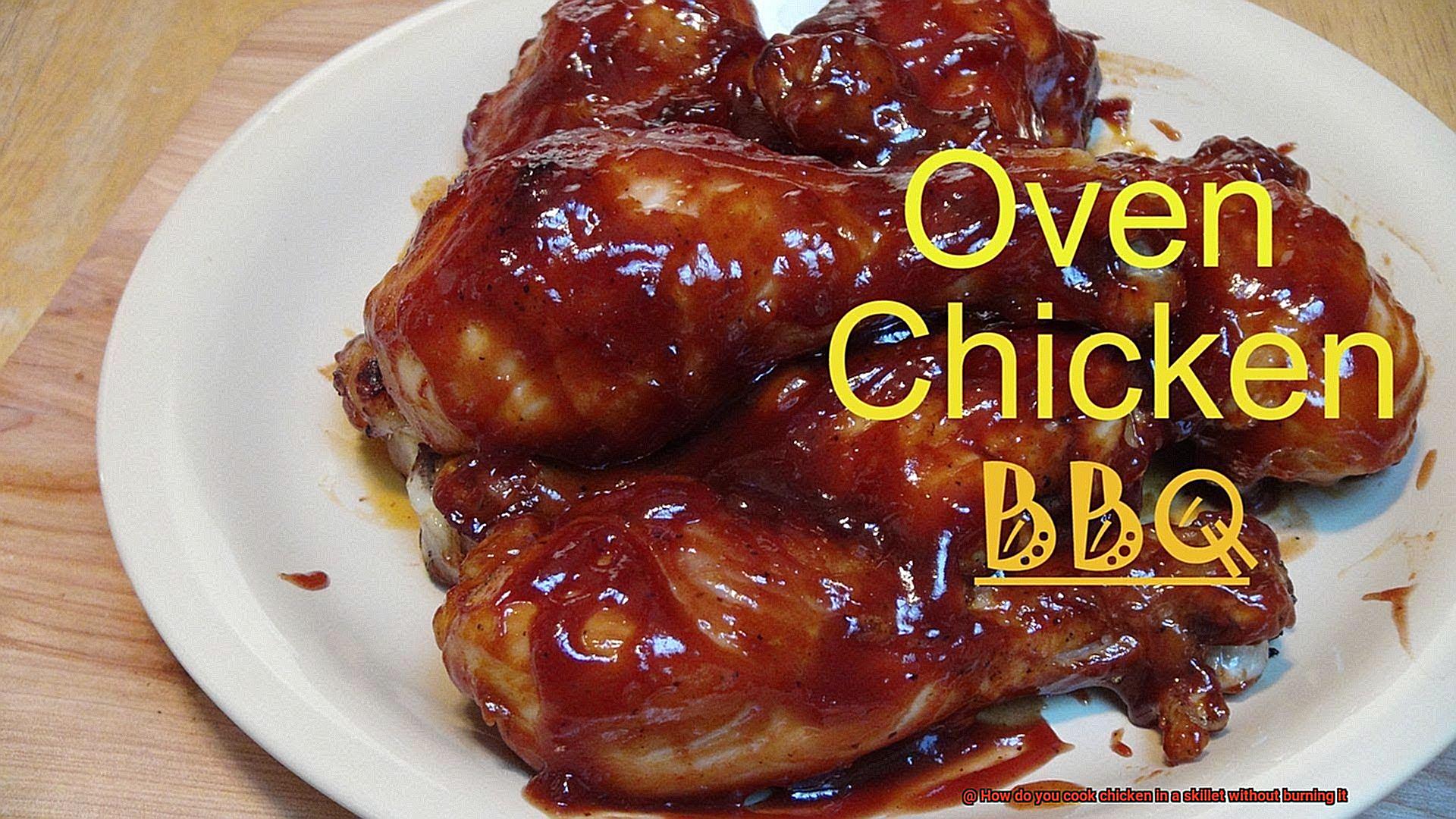
Use Medium Heat Settings on Your Stove
Firstly, high heat might seem like a good idea to cook your chicken faster, but it can lead to burning and drying out your meat. To avoid this, it’s best to use medium heat settings on your stove when cooking chicken in a skillet. This allows the chicken to cook through evenly without burning the exterior. It also gives you more control over the cooking process, allowing you to adjust the heat as needed to ensure that the chicken is cooked to perfection.
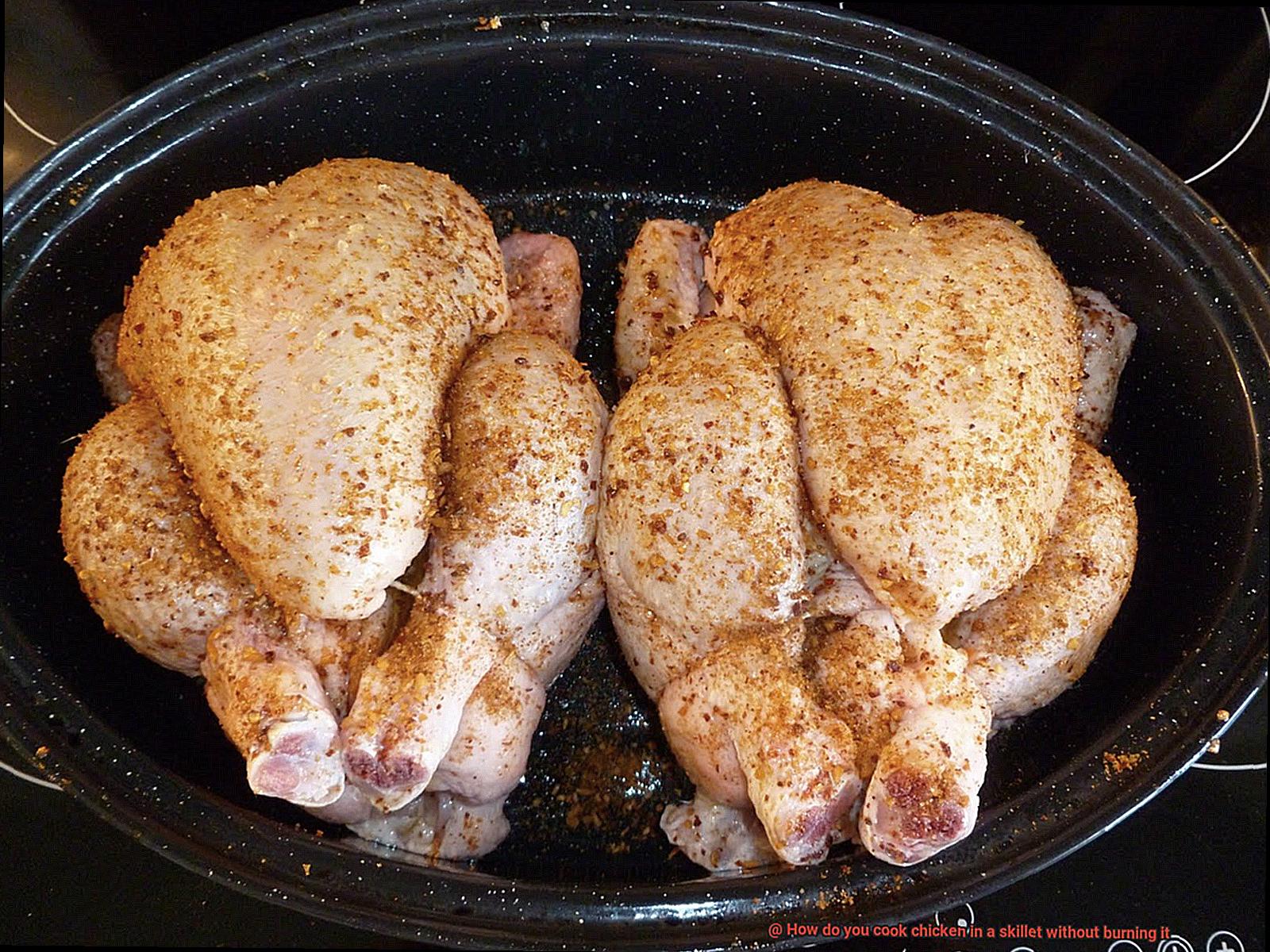
Additionally, using medium heat settings helps retain the moisture in the chicken. High heat can cause the juices to evaporate quickly, resulting in dry and tough meat. Medium heat, on the other hand, allows the chicken to cook through while retaining its moisture and tenderness.
To achieve perfectly cooked chicken every time, start by preheating your skillet before adding your chicken. This helps create that coveted crispy crust we all adore. Make sure your chicken is dry before adding it to the skillet, as wet chicken can cause oil to splatter, resulting in uneven cooking and potentially dangerous situations.
Bear in mind that cooking times will vary depending on the thickness of your chicken breasts or pieces. To ensure that your chicken is fully cooked, use a meat thermometer to check for an internal temperature of 165°F. This will ensure that any harmful bacteria are eliminated, and your chicken is safe to eat.
Use Oil or Butter Sparingly
Cooking chicken in a skillet can be a culinary challenge, but with the right techniques, you can create a mouthwatering dish without all the extra grease. The key is to use oil or butter sparingly.
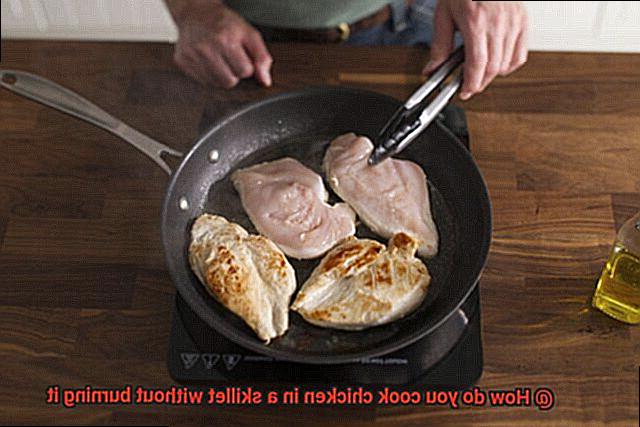
Firstly, it’s essential to choose the correct type of oil or butter for your recipe. For high-heat cooking, like skillet cooking, opt for oils with a high smoke point, such as vegetable or canola oil. Alternatively, butter can also work, but it has a lower smoke point and may burn more easily.
When it comes to adding oil or butter to the skillet, less is more. Use only enough to coat the bottom of the pan. To achieve this, pour a small amount of oil into the pan and use a paper towel or brush to spread it evenly across the surface. If using butter, wait until it’s fully melted before introducing the chicken.
Once the oil or butter is hot and ready, resist the urge to move or flip the chicken too frequently. Doing so can cause it to stick and rip apart, leading to uneven cooking and potentially burnt spots. Instead, let it cook undisturbed for a few minutes on each side until it develops a beautiful golden brown color.
If you find that the chicken is starting to burn despite using minimal amounts of oil or butter, reduce the heat slightly and adjust your cooking time accordingly. Additionally, using a non-stick skillet or adding a splash of water or chicken broth can create steam and prevent sticking.
In summary, using oil or butter sparingly and cooking your chicken patiently produces an incredibly delicious and healthy dish. Say goodbye to greasy and burnt meals by following these simple tips:
- Choose the right type of oil or butter for your recipe
- Use only enough oil or butter to coat the bottom of the pan
- Avoid constantly moving or flipping your chicken
- Adjust heat and time accordingly
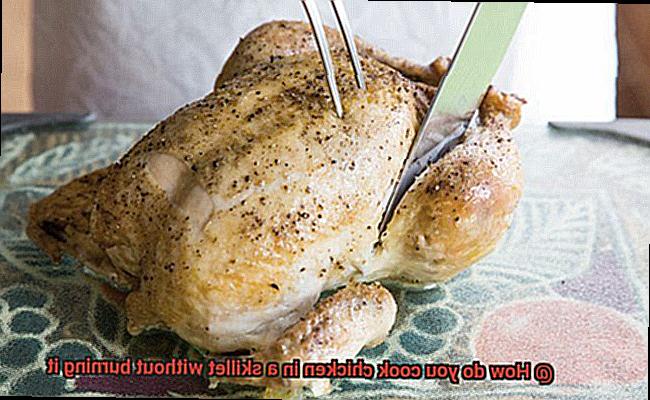
Utilize a Meat Thermometer
Fear not, dear reader, as there is a simple solution to this problem: utilizing a meat thermometer. This kitchen tool is crucial for determining the internal temperature of your chicken, ensuring that it’s cooked through without overcooking or burning it.
But what exactly is a meat thermometer, and why is it so essential? A meat thermometer is a handy kitchen gadget that measures the internal temperature of meat, poultry, or fish. By measuring the temperature, you can determine whether your food is cooked through and safe to eat. And when it comes to cooking chicken in a skillet, a meat thermometer can be a game-changer.
So how do you utilize a meat thermometer when cooking chicken in a skillet? It’s simple:
- Insert the probe: Before cooking the chicken, insert the probe of the meat thermometer into the thickest part of the chicken. Make sure that it doesn’t touch any bones.
- Wait for the reading: Once the chicken is cooked on one side, flip it over and wait for the thermometer to read the temperature. For chicken, the safe internal temperature is 165°F (74°C).
- Remove and rest: Once you have reached this temperature, remove the chicken from the skillet and let it rest for a few minutes before serving.
By following these steps, you can achieve perfectly cooked chicken every time without relying on guesswork or visual cues. And speaking of visual cues, it’s important to note that relying solely on color or texture can be misleading and may result in undercooked or burnt chicken. So don’t take any chances – invest in a meat thermometer today.
But wait, there’s more. Properly cleaning and sanitizing your meat thermometer after each use is crucial to prevent cross-contamination. You can do this by washing it with soap and warm water or wiping it down with rubbing alcohol.
Cook in Batches if Necessary
Fear not, because the solution is simple: cook in batches if necessary.
Overcrowding the pan with chicken can lead to uneven cooking and burning, which can ruin the flavor and texture of your dish. To avoid this, it’s best to cook your chicken in smaller batches. This may take a bit longer, but the end result will be a delicious and perfectly cooked dish.
To cook chicken in batches, start by preheating your skillet over medium-high heat and adding a small amount of oil. Once the oil is hot, carefully add a few pieces of chicken to the pan, making sure there is enough space between each piece. Allow the chicken to cook for a few minutes on each side until it reaches a golden brown color and is cooked through.
Once the first batch is done, remove it from the pan and set it aside. Add more oil to the pan if necessary and repeat the process with the remaining chicken. By cooking in batches, you ensure that each piece of chicken is cooked evenly and doesn’t burn.
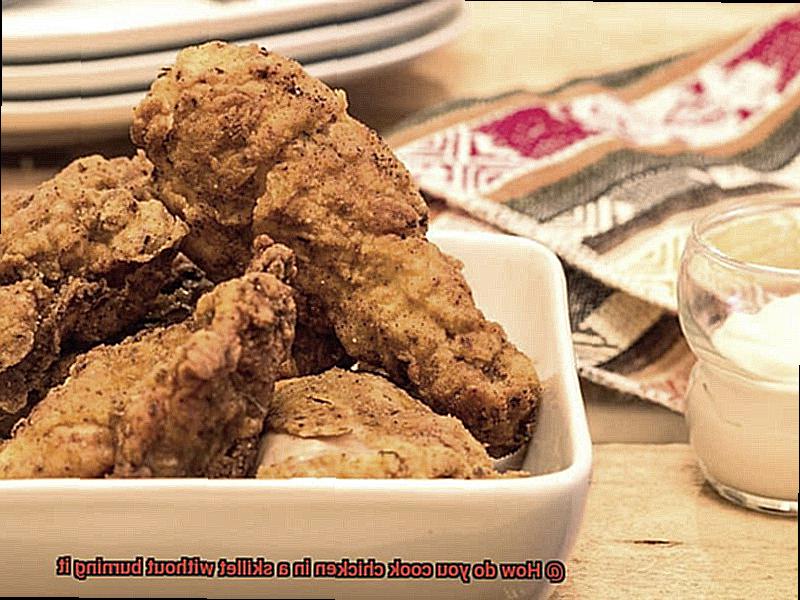
It’s important to monitor the temperature of your skillet when cooking in batches. If it gets too hot, turn down the heat slightly before adding more chicken to the pan. This will help prevent burning and ensure that all of your chicken is cooked to perfection.
So why bother cooking in batches? The answer is simple: it produces tender, juicy, and flavorful results every time. Cooking in batches may require a little extra time, but it’s well worth it for mouthwatering chicken that’s free from any burnt or overcooked pieces.
Tips for Perfectly Seared Chicken Every Time
Cooking chicken in a skillet can be tricky, especially when you want to achieve a perfectly seared crust without burning the meat. But fear not. With these tips, you can cook delicious and tender chicken every time.
Hot Skillet:
The first step to achieving a perfectly seared chicken is to use a hot skillet. A hot skillet will create a crispy outer layer while keeping the inside juicy and tender. To test if the skillet is hot enough, sprinkle a few drops of water on it – if they sizzle and evaporate immediately, the skillet is ready.
Seasoning:
Seasoning is key to adding flavor to your chicken. Generously season your chicken with salt and pepper before cooking. You can also add other spices or herbs like paprika, garlic powder, or rosemary to enhance the flavor even further.
Don’t Overcrowd:
Avoid overcrowding the skillet when cooking chicken. Overcrowding can lead to steaming instead of searing, resulting in rubbery texture and uneven cooking. Cook chicken in batches if needed.
Let Chicken Cook Undisturbed:
Allow the chicken to cook undisturbed for a few minutes before flipping it over. This allows for a nice crust to form on the outside of the chicken without sticking or tearing.
Use Meat Thermometer:
Using a meat thermometer is crucial to ensuring that the chicken is cooked through without overcooking it. The internal temperature should reach 165°F (74°C) to ensure it is safe to eat.
Conclusion
In conclusion, mastering the art of cooking chicken in a skillet requires patience, precision, and a few essential techniques. To start, select the right skillet that can handle high heat and distribute it evenly. Also, ensure that you season your chicken well with your preferred spices or herbs to add flavor.
Overcrowding the pan is a common mistake that leads to uneven cooking and burnt chicken. Instead, cook in batches if necessary, giving each piece ample space to cook evenly. Use medium heat settings on your stove to avoid scorching and oil or butter sparingly to prevent greasiness.
One of the best ways to achieve moist and juicy chicken is by using a meat thermometer. This tool will help you determine when your chicken is cooked through without overcooking it. Additionally, allowing the chicken to cook undisturbed for a few minutes before flipping it over will create that perfect sear.
By following these practical tips and tricks, you’ll be able to impress your family and friends with perfectly cooked chicken every time.

